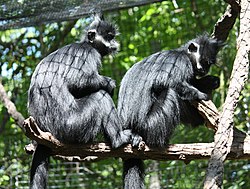Trachypithecus
Genus of Old World monkeys From Wikipedia, the free encyclopedia
Trachypithecus (derived from Greek τραχύς, trachýs meaning "rough" and πίθηκος, píthekos meaning "monkey") is a genus of Old World monkeys containing species known as lutungs, langurs, or leaf monkeys. Their range is much of Southeast Asia (northeast India, Vietnam, southern China, Borneo, Thailand, Java, and Bali).
| Trachypithecus | |
|---|---|
 | |
| Dusky leaf monkey (Trachypithecus obscurus) | |
| Scientific classification | |
| Domain: | Eukaryota |
| Kingdom: | Animalia |
| Phylum: | Chordata |
| Class: | Mammalia |
| Order: | Primates |
| Suborder: | Haplorhini |
| Infraorder: | Simiiformes |
| Family: | Cercopithecidae |
| Subfamily: | Colobinae |
| Tribe: | Presbytini |
| Genus: | Trachypithecus Reichenbach, 1862 |
| Type species | |
| Semnopithecus pyrrhus[1] | |
| Species | |
|
16, see text | |
The name "lutung" comes from the Sundanese language meaning "blackness", ultimately from Proto-Austronesian *luCuŋ (which originally referred to the Formosan rock macaque);[2] it is preferred in one paper because the authors wanted the name langurs to only refer to monkeys in the genus Semnopithecus,[3] although some "lutungs" are now "langurs" again.[4][5][6]
Evolution

Genetic analysis indicates that the ancestors of the modern species of lutung first differentiated from one another a little over 3 million years ago, during the late Pliocene. The various species alive today then diverged during the Pleistocene, presumably driven by habitat changes during the Ice Ages.[7] The oldest fossils clearly identified as belonging to the genus date from the middle Pleistocene of Vietnam and Laos; later fossils are also known from Thailand, Java, and Sumatra. The closest living relatives of the lutungs are probably either the gray langurs or the surilis, although the exact relationships remain unclear, possibly due to hybridisation between these genera during the course of their recent evolutionary history.[3]
Taxonomy
Summarize
Perspective
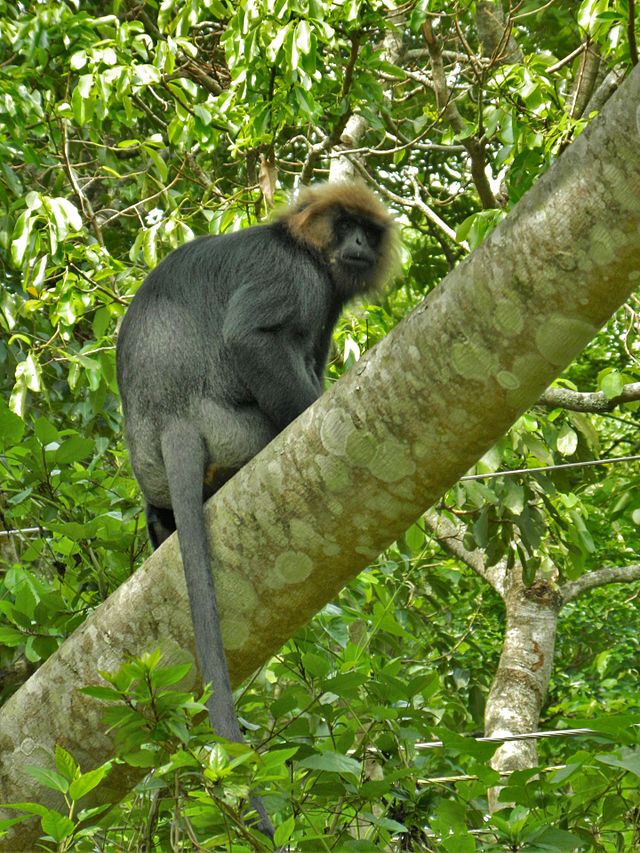
As of 2005, the authors of Mammal Species of the World recognize the following Trachypithecus species:[8]
- Genus Semnopithecus
- formerly T. vetulus group - moved into genus Semnopithecus in most recent classifications[9]
- Purple-faced langur, Semnopithecus vetulus
- Nilgiri langur, Semnopithecus johnii
- formerly T. vetulus group - moved into genus Semnopithecus in most recent classifications[9]
- Genus Trachypithecus
- T. cristatus group
- Javan lutung, Trachypithecus auratus
- "Silvery lutung", silvery langur, etc.: Trachypithecus cristatus, but also used for T. germaini
- Indochinese lutung or Germain's langur, Trachypithecus germaini
- Tenasserim lutung, Trachypithecus barbei
- T. obscurus group
- Dusky leaf monkey, Trachypithecus obscurus
- Phayre's leaf monkey, Trachypithecus phayrei
- T. pileatus group
- Capped langur, Trachypithecus pileatus
- Shortridge's langur, Trachypithecus shortridgei
- Gee's golden langur, Trachypithecus geei
- T. francoisi group
- Francois' langur, Trachypithecus francoisi
- Hatinh langur, Trachypithecus hatinhensis
- "White-headed langur", Trachypithecus poliocephalus
- Laotian langur, Trachypithecus laotum
- Delacour's langur, Trachypithecus delacouri
- Indochinese black langur, Trachypithecus ebenus
- T. cristatus group
Since then, the T. vetulus group (the purple-faced langur and the Nilgiri langur) have been moved the genus Semnopithecus based on DNA and other evidence.[4][10][11][12][13][14]
In 2008, Roos et al. described the Malay Peninsula form of the silvery lutung as a separate subspecies and subsequently it has been elevated to a separate species within the T. cristatus group as the Selangor silvered langur, T. selangorensis.[10][15] Roos et al. also elevated the West Javan Langur, Trachypithecus mauritius, and Annamese Langur, Trachypithecus margarita, to species status (formerly subspecies of T. auratus and T. germaini, respectively).[10][15] In 2020, Roos et al. discovered a new species, Popa langur (T. popa), which is found only in Myanmar.[16] Lastly, the White-headed langur (T. leucocephalus), previously thought to be a subspecies of the Francois langur (T. Francois) or Cat Ba langur (T. poliocephalus), is currently recognized as a distinct species by IUCN Red List assessors and the American Society of Mammalogists, based on a 2007 paper by Groves.[17][18][19]
This leaves the current understanding of the genus Trachypithecus to be:
| Common name | Scientific name and subspecies | Range | Size and ecology | IUCN status and estimated population |
|---|---|---|---|---|
| Annamese langur | T. margarita (Elliot, 1909) |
Southeastern Asia |
Size: 40–76 cm (16–30 in) long, plus 57–110 cm (22–43 in) tail[20] Habitat: Forest[21] Diet: Leaves, flowers, and fruit[20] |
EN
|
| Capped langur | T. pileatus (Blyth, 1843) Three subspecies
|
Southern Asia |
Size: 40–76 cm (16–30 in) long, plus 57–110 cm (22–43 in) tail[20] Habitat: Forest[22] Diet: Leaves, seeds, and fruit, as well as flowers, buds, bark, and caterpillars[22] |
VU
|
| Cat Ba langur | T. poliocephalus (Pousargues, 1898) |
Cát Bà Island, Vietnam (in purple) |
Size: 40–76 cm (16–30 in) long, plus 57–110 cm (22–43 in) tail[20] Habitat: Forests and caves[23] Diet: Leaves, flowers, and fruit[20] |
CR
|
| Delacour's langur | T. delacouri (Osgood, 1911) |
Northern Vietnam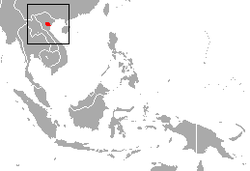 |
Size: 40–76 cm (16–30 in) long, plus 57–110 cm (22–43 in) tail[20] Habitat: Forest, rocky areas, and caves[24] Diet: Leaves, flowers, and fruit[20] |
CR
|
| Dusky leaf monkey | T. obscurus (Reid, 1837) Seven subspecies
|
Southeastern Asia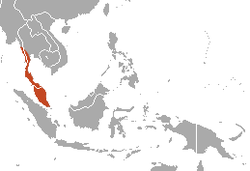 |
Size: 42–61 cm (17–24 in) long, plus 50–85 cm (20–33 in) tail[25] Habitat: Forest[26] Diet: Leaves, shoots, fruit, and seedlings[25] |
EN
|
| East Javan langur | T. auratus (É. Geoffroy, 1812) |
Java and nearby islands in Indonesia |
Size: 44–65 cm (17–26 in) long, plus 61–87 cm (24–34 in) tail[27] Habitat: Forest[28] Diet: Leaves and flowers, as well as fruit and insect larvae[27] |
VU
|
| François' langur | T. francoisi (Pousargues, 1898) |
Southern Asia |
Size: 40–76 cm (16–30 in) long, plus 57–110 cm (22–43 in) tail[20] Habitat: Forest, rocky areas, and caves[29] Diet: Leaves, fruit, and seeds, as well as insects[30] |
EN
|
| Gee's golden langur | T. geei (Khajuria, 1956) |
Southern Asia |
Size: 50–75 cm (20–30 in) long, plus 70–100 cm (28–39 in) tail[31] Habitat: Forest[32] Diet: Fruit, leaves, flowers, seeds, and twigs[31] |
EN
|
| Germain's langur | T. germaini (A. Milne-Edwards, 1876) |
Southeastern Asia |
Size: 40–76 cm (16–30 in) long, plus 57–110 cm (22–43 in) tail[20] Habitat: Forest and rocky areas[33] Diet: Leaves, fruit, and flowers[33] |
EN
|
| Hatinh langur | T. hatinhensis (Dao, 1970) |
Vietnam |
Size: 40–76 cm (16–30 in) long, plus 57–110 cm (22–43 in) tail[20] Habitat: Forest, rocky areas, and caves[34] Diet: Leaves, as well as fruit, vines, and flowers[34] |
EN
|
| Indochinese black langur
|
T. ebenus (Brandon-Jones, 1995) |
Southeastern Asia | Size: 40–76 cm (16–30 in) long, plus 57–110 cm (22–43 in) tail[20] Habitat: Forest, rocky areas, and caves[34] Diet: Leaves, as well as fruit, vines, and flowers[34] |
EN
|
| Indochinese grey langur | T. crepuscula (Elliot, 1909) |
Southeast Asia (in red) |
Size: 40–76 cm (16–30 in) long, plus 57–110 cm (22–43 in) tail[20] Habitat: Forest, inland wetlands, and rocky areas[35] Diet: Leaves, flowers, and fruit[20] |
EN
|
| Laotian langur | T. laotum (Thomas, 1911) |
Laos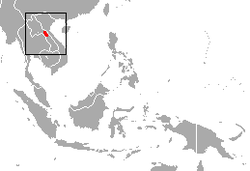 |
Size: 40–76 cm (16–30 in) long, plus 57–110 cm (22–43 in) tail[20] Habitat: Forest and rocky areas[36] Diet: Leaves, flowers, and fruit[20] |
EN
|
| Phayre's leaf monkey | T. phayrei (Blyth, 1847) Two subspecies
|
Southeast Asia (in green) |
Size: 40–76 cm (16–30 in) long, plus 57–110 cm (22–43 in) tail[20] Habitat: Forest[37] Diet: Leaves, as well as bamboo shoots[38] |
EN
|
| Popa langur
|
T. popa Roos et al., 2020 |
Myanmar |
Size: 40–76 cm (16–30 in) long, plus 57–110 cm (22–43 in) tail[20] Habitat: Forest[39] Diet: Leaves, flowers, and fruit[20] |
CR
|
| Shortridge's langur | T. shortridgei (Wroughton, 1915) |
Southern Asia |
Size: 40–76 cm (16–30 in) long, plus 57–110 cm (22–43 in) tail[20] Habitat: Forest[40] Diet: Leaves, flowers, and fruit[20] |
EN
|
| Selangor silvered langur | T. selangorensis Roos, Nadler, Walter, 2008 |
Peninsular Malaysia | Size: 40–76 cm (16–30 in) long, plus 57–110 cm (22–43 in) tail[20] Habitat: Forest[41] Diet: Leaves, flowers, and fruit[20] |
NT
|
| Silvery lutung | T. cristatus (Raffles, 1821) Two subspecies
|
Southeastern Asia |
Size: 46–56 cm (18–22 in) long, plus 63–84 cm (25–33 in) tail[42] Habitat: Forest[43] Diet: Leaves, as well as fruit, seeds, shoots, flowers, and buds[42] |
VU
|
| Tenasserim lutung
|
T. barbei (Blyth, 1847) |
Southeastern Asia |
Size: 40–76 cm (16–30 in) long, plus 57–110 cm (22–43 in) tail[20] Habitat: Forest[44] Diet: Leaves, flowers, and fruit[20] |
VU
|
| West Javan langur | T. mauritius (Griffith, 1821) |
Island of Java | Size: 40–76 cm (16–30 in) long, plus 57–110 cm (22–43 in) tail[20] Habitat: Forest[45] Diet: Leaves, flowers, and fruit[20] |
VU
|
| White-headed langur | T. leucocephalus Tan, 1957 |
Southern China | Size: 40–76 cm (16–30 in) long, plus 57–110 cm (22–43 in) tail[20] Habitat: Rocky areas[17] Diet: Leaves, flowers, and fruit[20] |
CR
|
Physical description
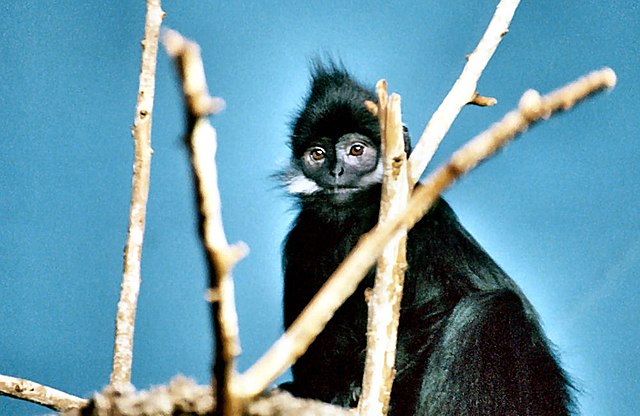
Lutungs have a rather slim build with a long tail. The fur color varies, depending on the species, from black and grey to orange yellow. Many species have skin designs and a brighter lower surface, the hair on the head is often compared to a hood. Their arms are very short in comparison to the feet and their thumbs are also somewhat shorter. The inner surfaces of the hands and feet are hairless so that their fur does not get caught when reaching into branches. These animals reach a length of 40 to 80 cm and a weight of 5 to 15 kg, with males generally larger than females. A bulge over the eyes and other details, primarily in the head, differentiate it from the surilis.
Habitat and distribution
Lutungs live in the forests, often preferring rain forests, although occasionally they are also found in secluded mountain forests. Lutungs are found in South-east Asia and parts of South Asia from India in the west to China in the east.[46]
Behaviour
Summarize
Perspective
They spend the largest part of the day in the trees, where they crawl along the branches on all fours, although they can also jump well from tree to tree. They are diurnal, although more active in the early mornings and the afternoon.
They live in groups of five to 20 animals, mostly in harems, i.e. a single male with several females. Young males must leave their birth group when fully mature, often forming bachelor groups. If a new male takes over a harem, defeating and scaring off the harem leader, he often kills the children of the group. Lutungs are territorial, with loud shouting to defend their territories from other lutung interlopers, resorting to force if the outsiders are not scared off. They have a common repertoire of sounds with which they warn group members. Also, mutual grooming plays an important role.
Lutungs are herbivores, primarily eating leaves, fruits, and buds. To digest the tough leaves, they developed a multichambered stomach.
Reproduction
Rarely twins, a typical single birth comes after a seven-month gestation period. Newborns usually have a golden-yellow fur. The mother shares responsibilities of rearing the young with the other females ("aunties") of the harem. They hand the young around, play with it, carry it, and cuddle it, while the mother searches for food. If the mother dies, another female adopts the young animal. Lutungs are weaned in the latter half of their first year, and reach full maturity at 4 to 5 years. The life expectancy is estimated at 20 years.
References
Sources
External links
Wikiwand - on
Seamless Wikipedia browsing. On steroids.







